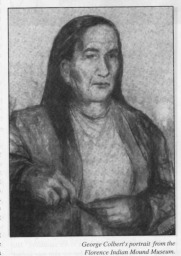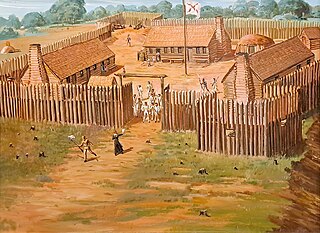
The Chickasaw are an Indigenous people of the Southeastern Woodlands, United States. Their traditional territory was in northern Mississippi, northwestern and northern Alabama, western Tennessee and southwestern Kentucky. Their language is classified as a member of the Muskogean language family. In the present day, they are organized as the federally recognized Chickasaw Nation.
The Battle of Helena was fought on July 4, 1863, near Helena, Arkansas, during the American Civil War. Union troops captured the city in July 1862, and had been using it as a base of operations. Over 7,500 Confederate troops led by Lieutenant General Theophilus Holmes attempted to capture Helena in hopes of relieving some of the pressure on the Confederate army besieged in Vicksburg, Mississippi. Helena was defended by about 4,100 Union troops led by Major General Benjamin Prentiss, manning one fort and four batteries of artillery.

The Arkansas Post, formally the Arkansas Post National Memorial, was the first European settlement in the Mississippi Alluvial Plain and present-day U.S. state of Arkansas. In 1686, Henri de Tonti established it on behalf of Louis XIV of France for the purpose of trading with the Quapaw Nation. The French, Spanish, and Americans, who acquired the territory in 1803 with the Louisiana Purchase, considered the site of strategic value. It was the capital of Arkansas from 1819 until 1821 when the territorial government relocated to Little Rock.

The Battle of Arkansas Post, also known as Battle of Fort Hindman, was fought from January 9 to 11, 1863, near the mouth of the Arkansas River at Arkansas Post, Arkansas, as part of the Vicksburg Campaign of the American Civil War. Confederate forces had constructed a fort known as Fort Hindman near Arkansas Post in late 1862. In December of that year, a Union force under the command of Major-General William T. Sherman left for an expedition against Vicksburg, without Major-General John A. McClernand because neither Major-Generals Henry Halleck nor Ulysses S. Grant trusted McClernand. After Sherman's force was repulsed at Chickasaw Bayou, McClernand arrived and took command from Sherman in January 1863.

The Vicksburg campaign was a series of maneuvers and battles in the Western Theater of the American Civil War directed against Vicksburg, Mississippi, a fortress city that dominated the last Confederate-controlled section of the Mississippi River. The Union Army of the Tennessee under Major General Ulysses S. Grant gained control of the river by capturing this stronghold and defeating Lieutenant General John C. Pemberton's forces stationed there.

The Chickasaw Campaign of 1736, also known as the First Chickasaw War, consisted of two pitched battles by the French and allies against Chickasaw fortified villages in present-day Northeast Mississippi. Under the overall direction of the governor of Louisiana, Jean-Baptiste Le Moyne de Bienville, a force from Upper Louisiana attacked Ogoula Tchetoka on March 25, 1736. A second force from Lower Louisiana attacked Ackia on May 26, 1736. Both attacks were bloodily repulsed.

The Battle of Big Black River Bridge was fought on May 17, 1863, as part of the Vicksburg Campaign of the American Civil War. During the war, the city of Vicksburg, Mississippi, was a key point on the Mississippi River. On April 30, 1863, a Union army commanded by Major General Ulysses S. Grant began crossing onto the east side of the Mississippi River as part of a campaign against Vicksburg. After engaging and defeating Confederate forces in several intermediate battles, Grant's army defeated Lieutenant General John C. Pemberton's Confederates at the decisive Battle of Champion Hill on May 16. During the retreat from Champion Hill, one division of Pemberton's army, commanded by Major General William W. Loring, was cut off from Pemberton's main body. Pemberton did not know the location of Loring's division, and he held a bridgehead on the east side of the Big Black River to cover Loring's anticipated withdrawal across the river on the morning of May 17.

The Battle of Chickasaw Bayou, also called the Battle of Walnut Hills, fought December 26–29, 1862, was the opening engagement of the Vicksburg Campaign during the American Civil War. Confederate forces under Lt. Gen. John C. Pemberton repulsed an advance by Union Maj. Gen. William T. Sherman that was intended to lead to the capture of Vicksburg, Mississippi.

USS Marmora was a sternwheel steamer that served in the Union Navy from 1862 to 1865, during the American Civil War. Built in 1862 at Monongahela, Pennsylvania, as a civilian vessel, she was purchased for military service on September 17 and converted into a tinclad warship. Commissioned on October 21, the vessel served on the Yazoo River beginning the next month. She encountered Confederate naval mines on the Yazoo on December 11, and was present the next day when the ironclad USS Cairo was sunk by two mines. After further service on the Yazoo during the Battle of Chickasaw Bayou in late December, Marmora was assigned in January 1863 to a fleet that was preparing to operate against Confederate Fort Hindman, but was not present when the fort surrendered on January 11.

The Battle of Grand Gulf was fought on April 29, 1863, during the American Civil War. Union Army forces commanded by Major General Ulysses S. Grant had failed several times to bypass or capture the Confederate-held city of Vicksburg, Mississippi, during the Vicksburg campaign. Grant decided to move his army south of Vicksburg, cross the Mississippi River, and then advance on the city. A Confederate Army division under Brigadier General John S. Bowen prepared defenses—Forts Wade and Cobun—at Grand Gulf, Mississippi, south of Vicksburg. To clear the way for a Union crossing, seven Union Navy ironclad warships from the Mississippi Squadron commanded by Admiral David Dixon Porter bombarded the Confederate defenses at Grand Gulf on April 29. Union fire silenced Fort Wade and killed its commander, but the overall Confederate position held. Grant decided to cross the river elsewhere.

The Battle of Snyder's Bluff was fought from April 29 to May 1, 1863, during the Vicksburg Campaign of the American Civil War. Federal Major General Ulysses S. Grant had decided to move most of his army down the west bank of the Mississippi River and then cross south of Vicksburg, Mississippi, at Grand Gulf as part of his campaign against the city. To cover his planned crossing, Major General William T. Sherman took Francis P. Blair Jr.'s division of his XV Corps on a maneuver up the Yazoo River to feint at Confederate defenses at Snyder's Bluff and Drumgould's Bluff.

The Battle of St. Charles was fought on June 17, 1862, at St. Charles, Arkansas, during the American Civil War. Earlier in 1862, a Union Army force commanded by Major General Samuel R. Curtis moved against Little Rock, Arkansas, but became bogged down in the Batesville area due to lack of supplies. The Union leadership decided to send a naval force from Memphis, Tennessee, up the White River to resupply Curtis's men. Major General Thomas C. Hindman, the Confederate commander in Arkansas, had fortifications constructed near St. Charles to stop the Union movement. Two artillery positions were built, and three ships, including CSS Maurepas, were scuttled to obstruct the river.
Levi Colbert was an early 19th-century Chickasaw leader and the namesake of Itawamba County, Mississippi.

Fort Jefferson was a town on the Mississippi River, about one mile south of Wickliffe, Kentucky in southwestern Ballard County.

George Colbert was an early 19th-century Chickasaw leader. During the Creek War he commanded 350 Chickasaw auxiliary troops whom he had recruited, as a senior officer of militia, under Andrew Jackson. At the end of the War of 1812, he served a second time under Jackson.
The Van Buren raid occurred in Crawford County, Arkansas, on December 28, 1862, during the American Civil War. After defeating Confederate forces led by Major General Thomas C. Hindman at the Battle of Prairie Grove on December 7, 1862, Union forces under Brigadiers General James G. Blunt and Francis J. Herron prepared for a raid against the Confederate positions at Van Buren and Fort Smith. Disease, lack of supplies, and desertion had previously forced Hindman to begin withdrawing most of his force from the area. Setting out on December 27, the Union troops struck an outlying Confederate cavalry unit near Drippings Spring, north of Van Buren, on the morning of December 28. The Confederate cavalry fled to Van Buren, which was then overrun by Union troops.

Fort Carlos III was a Spanish fort located at the Écores Rouges, Luisiana, within the present-day Arkansas Post National Memorial. Named for King Carlos III, it was located on the left bank of the Arkansas, about 29 miles from the mouth. This wooden palisade fort comprised a stockade, bastions, embrasures, storehouses, barracks, officers' quarters, a powder magazine, cannons, swivel guns, and ordnance stores. The fort served as the headquarters of Spain's district of Arkansas from 1781 until 1791 when it was destroyed by erosion and replaced by Fort San Esteban.
The 13th Missouri Cavalry Regiment was a cavalry unit that served in the Confederate States Army during the American Civil War. In early April 1863, Captain Robert C. Wood, aide-de-camp to Confederate Major General Sterling Price, was detached to form an artillery unit from some of the men of Price's escort. Wood continued recruiting for the unit, which was armed with four Williams guns, and grew to 275 men by the end of September. The next month, the unit fought in the Battle of Pine Bluff, driving back Union Army troops into a barricaded defensive position, from which the Union soldiers could not be dislodged. By November, the unit, which was known as Wood's Missouri Cavalry Battalion, had grown to 400 men but no longer had the Williams guns. In April 1864, Wood's battalion, which was also known as the 14th Missouri Cavalry Battalion, played a minor role in the defeat of a Union foraging party in the Battle of Poison Spring, before spending the summer of 1864 at Princeton, Arkansas. In September, the unit joined Price's Raid into the state of Missouri, but their assault during the Battle of Pilot Knob failed to capture Fort Davidson.
The 10th Texas Field Battery was an artillery battery that served in the Confederate States Army during the American Civil War. After being formed in early 1861 by Benjamin H. Pratt, the battery served with a cavalry formation led by Colonel William Henry Parsons for part of 1862. It was called upon to enter Missouri in support of troop movements related to the Battle of Prairie Grove, but this did not occur. It then operated along the Mississippi River in early 1863, harassing enemy shipping. The unit then participated in Marmaduke's Second Expedition into Missouri and the Battle of Pine Bluff in 1863. Late in 1864, the battery, now under the command of H. C. Hynson, served in Price's Raid, participating in several battles and skirmishes, including the disastrous Battle of Mine Creek. One source claims the unit's service ended on May 26, 1865, while a Confederate report dated June 1, 1865, states that it existed but did not have cannons. Confederate forces in the Trans-Mississippi Department surrendered on June 2.
James Logan Colbert was a Scottish trader and military officer who lived much of his life among the Chickasaw. He served as an officer of the British Army who commanded an independent company in the Western Theater of the American Revolutionary War. In 1783, Colbert led an unsuccessful raid on the Spanish village of Arkansas Post, Louisiana in an attempt to capture Fort Carlos III.















